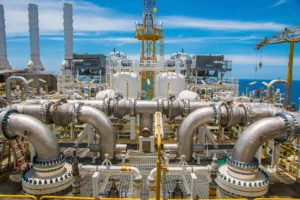Air, or pneumatic, motors convert compressed air energy to mechanical work through linear or rotary motion. Several different designs are available, of which vane, piston, and turbine motors are the most common. The turbine air motor is the preferred choice for high power applications requiring high speed and low starting torque.
The turbine air motor uses a nozzle that directs air to a turbine wheel. The wheel contains a rotor with curved blades. When compressed air is pushed through the nozzle, it hits the blades and turns the rotor. The system changes the incoming high-pressure, low-velocity air flow to a low-pressure, high-velocity flow. Changing the number of nozzles changes the power output proportionally.
The turbine air motor converts pneumatic power to mechanical power at an efficiency rate of approximately 65-75%, making it the most efficient air motor design. This property is facilitated thanks to the absence of sliding contact points causing internal friction, which also means that the turbine air motor has no need for any extensive lubrication. Turbine air motors are relatively compact and lightweight in relation to the power they deliver. Another operational advantage is that the turbine air motor, on average, uses less than one third of the compressed air needed by the more common vane motor.
Because of their adaptability, dependability, and appropriateness for a variety of operating conditions, air motors, often referred to as pneumatic motors, are utilized in a broad range of industrial and commercial applications. Typical applications for air motors include:
- Manufacturing and Assembly: Conveyor systems, assembly line equipment, and machinery are just a few of the jobs that air motors are frequently utilized for in these procedures.
- Automobile Industry: Pneumatic tool powering, robotic arm operation, and conveyor belt driving are just a few of the jobs that air motors do in automobile assembly lines.
- Material Handling: Hoists, winches, and lifting platforms are examples of equipment that uses air motors.
- Mining and Construction: In order to drill, cut, grind, and power pneumatic tools in hostile settings, air motors are utilized in mining and construction equipment.
- Marine Applications: Because air motors are flammable and resistant to corrosion, they are used in marine equipment, including winches, cranes, and hoists on ships and offshore platforms.
Turbine air motors are used where very high speed but very low starting torque is required. Typical application areas are, for example, dental drills. In general, turbine air motors offer highly efficient pneumatic starters that require no lubrication and little maintenance. As such, they are used not only as jet aircraft starters but also to start reciprocating engines of all sizes. Turbine air motors are also highly suitable for robot-controlled applications, in applications where space is a constraint, and in high quality manual machinery.
An air turbine motor is a kind of pneumatic motor that turns the energy of expanding air into rotational motion by using a turbine mechanism. Compressed air is directed onto a rotor’s blades in an air turbine motor, spinning the rotor. This circular motion might be employed for labor or to drive different mechanical parts.
The methods by which a vane motor and a turbine motor transform compressed air energy into rotational motion are the main distinctions between them:
1. Vane Motor: A vane motor has vanes on its rotor that are forced outward by expanding air and come into contact with the motor housing’s inner surface, rotating the rotor.
2. Turbine Motor: A turbine motor functions similarly to a wind turbine, with its rotor housing blades that are rotated by the force of expanding air passing over them.
It’s difficult to single out one type of air motor as the “most efficient” since efficiency varies based on several parameters, including design, operating circumstances, and application requirements. On the other hand, gear and vane motors are often more efficient than turbine or piston motors. Furthermore, all kinds of air motors are becoming more efficient due to technological improvements.
Atlas Copco offers the market’s most comprehensive and technology-leading portfolio of vane, piston, and turbine air motors. Coupled with planetary and helical gear combinations, offering a solution to even the most challenging needs and requirements in industrial manufacturing.
To learn more about turbine air motor models, click here. Check out our video, “Our air motor technologies: vane, piston and turbine” or contact us today!


